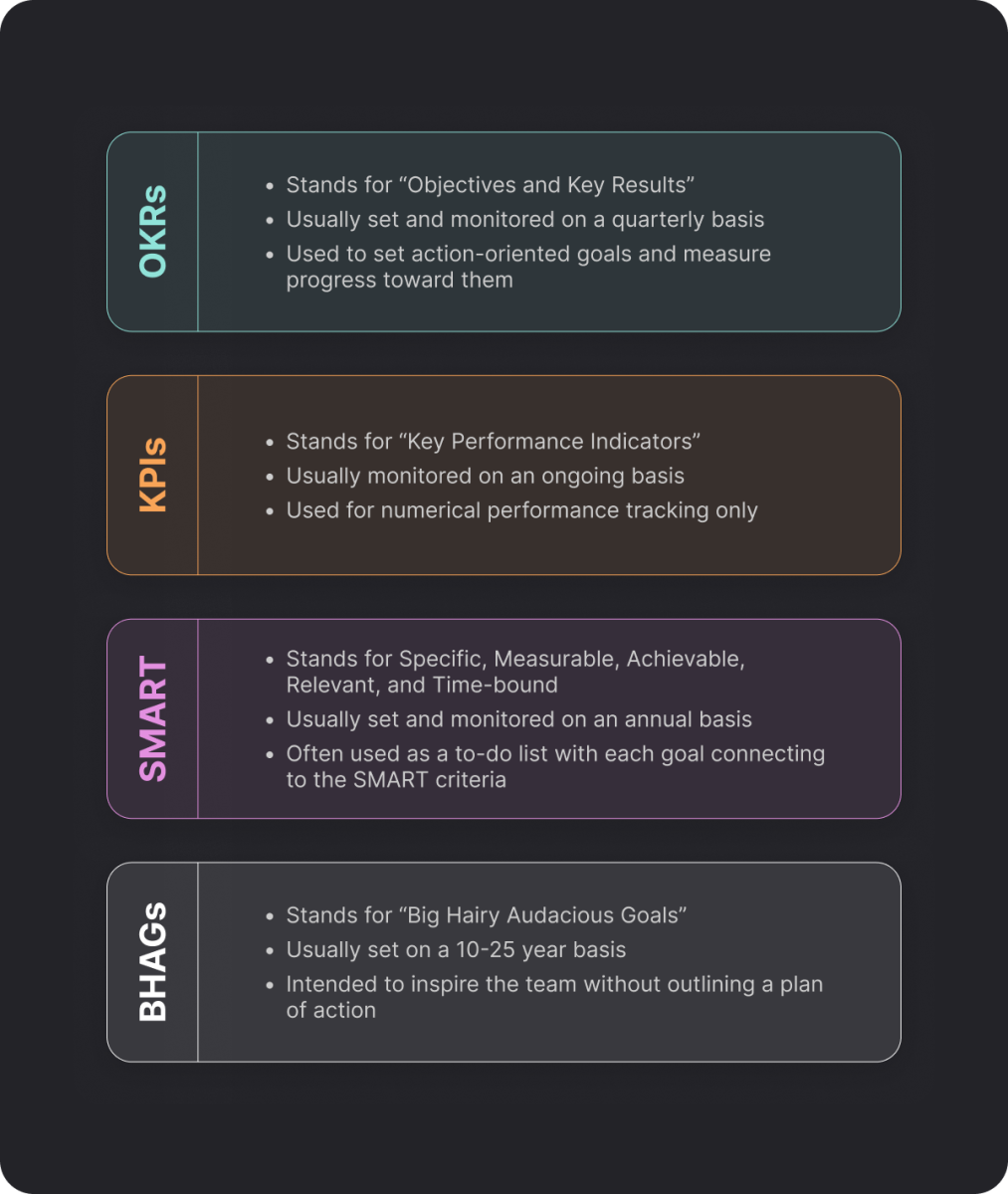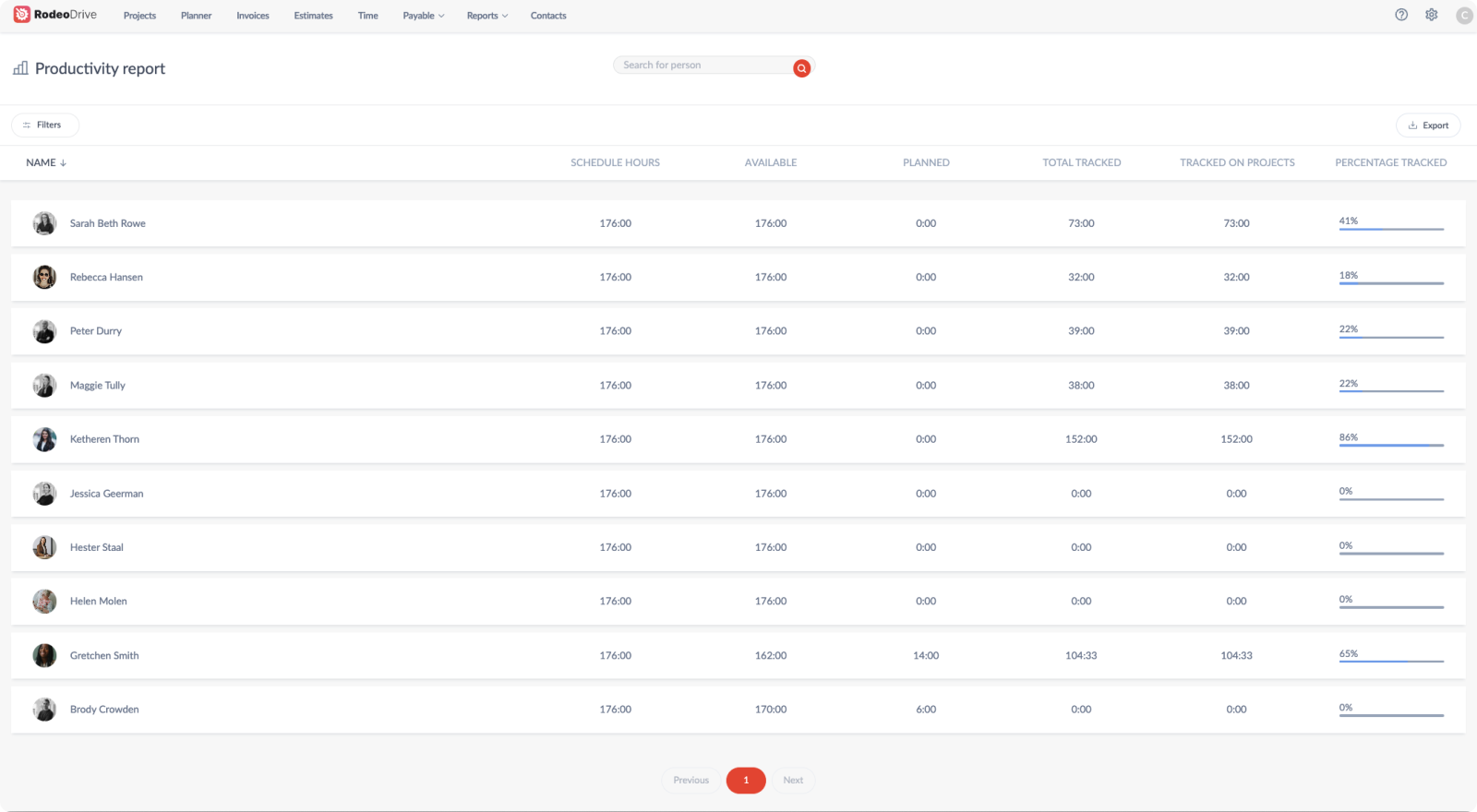How to Set Marketing OKRs in 10 Steps
Having a goal-setting framework in place is invaluable for marketing teams. Without a framework in place, how can your team know if they’ve met or exceeded expectations?
Many marketing teams choose to adopt OKRs, as OKRs are high-level and ambitious goals that push teams to achieve their full potential. OKRs help team members understand the organization’s larger goals, as well as how their day-to-day activities can make an impact.
By the end of this blog, you’ll have a better understanding of what OKRs are, how they’re unique from other goal-setting strategies, and some marketing OKR examples.
Let’s get started!
What are marketing OKRs?
OKRs are a goal-setting framework that teams across industries can use to set goals and measure progress. It stands for Objectives and Key Results, which means setting OKRs involves outlining a high-level objective as well as the key activities you’ll enact in order to achieve numerically significant results.
From a marketing project management perspective, think of OKRs as a way to improve team accountability by establishing clear checkpoints to ensure the team is making appropriate progress toward its overarching objective. Without an OKR framework in place, it’s all too easy to fall behind on your objectives.
OKRs are often used to push teams beyond their perception of what’s possible, as OKRs are typically extremely ambitious goals that you’re unlikely to fully meet – otherwise, they aren’t ambitious enough. Because of this, there will inevitably be successes, failures, and discomfort.
Setting OKRs is also a useful tactic across departments, and publicizing them to everyone in the organization helps to create transparency. Since failure to achieve OKRs is not a reflection of employee performance – nor are they a to-do list – there’s no reason to not ensure everyone’s on the same page about what’s being worked on.
Related: Goals vs. Objectives: Is There a Difference?
Why choose marketing OKRs over another goal-setting framework
Seasoned marketing professionals are likely familiar with multiple different types of goal-setting frameworks, as organizations use many different types. Here’s a look at some of the most common strategies for marketing teams besides OKRs:
-
Key Performance Indicators (KPIs): KPIs serve to track performance over time or against a target. While KPIs can be connected to strategic goals, they’re heavily dependent on numerical metrics – more so than other goal frameworks. For example, many KPIs consist of ratios or rates as a way to track performance.
-
SMART Goals: SMART stands for Specific, Measurable, Achievable, Relevant, and Time-bound. These goals typically relate to a single metric and are usually used to track individual efforts rather than that of a team. SMART goals are often set annually, making them less flexible according to the organization’s changing needs.
-
Big Hairy Audacious Goals (BHAGs): BHAGs are long-term stretch goals that typically take 10-25 years to complete that are intended to inspire the team. These goals, although vague, lay the groundwork for team activities. For example, Microsoft’s BHAG was to put a computer on every desk and in every home.

So, how do these other strategies compare to OKRs?
For starters, OKRs tend to look at the bigger picture, with the objective serving as a guide for lower-level activities. Managers or department leads are typically the ones who set the OKR objectives, which then determine the key results that employees will work toward.
In contrast, SMART goals lack high-level objectives and are rather a collection of goals based on the criteria of each acronym. As you might’ve already gathered, KPIs differ from SMART goals, BHAGs, and OKRs as they’re solely focused on performance outcomes rather than how those outcomes are achieved.
BHAG stands apart from the other frameworks because it’s far less actionable than the other techniques. You’ll likely need to use SMART goals, KPIs, or OKRs to achieve your BHAG.
Failure to meet SMART goals or certain KPIs may reflect on employee performance, whereas this isn’t always true for OKRs, since they’re typically too ambitious for teams to meet 100% of the time.
Related: Benchmarking in Project Management: Definition, Approaches, and Best Practices

How to set marketing OKRs in 10 steps
The process of setting marketing OKRs is actually rather simple, although you don’t want to forget anything. Here’s a look at the 10 steps you’ll want to follow to build strong OKRs:
1. Determine organization-wide goals for the upcoming period
The best way to start setting marketing OKRs is to first examine your organization’s goals for the upcoming quarter. These might look different depending on the type of marketing organization you’re a part of.
Marketing agencies that are project-based will likely have organizational goals that are based on the completion of client work or client satisfaction levels, whereas in-house marketing teams might be focused on the launch of a new product, for example.
Regardless, collaborating with higher-level management to understand what the organization wants to achieve is a great first step in developing marketing OKRs that further the needs of the firm as a whole.
Related: The Project Management Checklist: 12 Steps to Follow
.png)
2. Break goals into marketing-specific objectives
Now that you’re familiar with what the organization hopes to achieve in the upcoming period, it’s time to break those goals down into tangible marketing objectives. Setting objectives on a departmental level helps focus your team members and makes it more clear how they’re contributing to the overall success of the company.
We’ll get into what those objectives might look like later in this blog, but they can include a range of things, such as launching a newsletter, successfully deploying a social media campaign on a new platform, or improving your website’s SEO in order to reach a larger customer audience.
Also read: How to Effectively Manage Marketing Campaigns
3. Decide whether your OKRs will be aspirational or committed
There are two schools of thought with OKRs. On one hand, some teams like to set aspirational OKRs that they’re unlikely to fully achieve as a way to push a higher level of performance. With aspirational OKRs, you’ll typically reach 60 to 70% of your targets if you’ve appropriately challenged the team.
But if you’re used to SMART goals and are new to using an OKR framework, you’ll probably find committed OKRs to be closer to what you’re used to, as these are reasonable targets that you’re expected – and are likely – to reach.
4. Establish key results for each objective
Your objectives are the “what,” and your key results are the “how.” Your team’s key results will help you measure progress, as once you’ve fulfilled the key results, your objectives will have been met.
So, when you’re at this step, ask yourself: what does achieving this objective look like? For instance, if your objective is to boost your social media engagement, what metrics do you need to measure in order to know if you’ve done that? Perhaps gaining followers will be one of your key results.
5. Numerically define your key results
While your objectives might vary in terms of how specific they are, it’s important for your key results to include a numeric measure of your progress.
For instance, if we take the previous example of using gaining followers as one of your key results, you’ll want to specify exactly how many followers you’re aiming to gain. Otherwise, your key results will lack the specificity needed to be effective OKRs.

6. Set up a schedule
Other goal-setting frameworks work within a variety of schedules and timelines, however, OKRs tend to work best when on a quarterly schedule. Since OKRs are highly specific, a quarterly schedule keeps your objectives dynamic and allows your team to pivot as organizational needs change.
If you set OKRs that are too ambitious during Q1, a fast-paced schedule means you’re able to learn from this experience and quickly adapt and adjust your objectives before the next quarter begins.
Also read: Marketing Management Tasks to Prioritize for Successful Results
.png)
7. Decide the tools or systems you’ll use for monitoring
Now that your OKRs are in place, it’s time to think about how you’ll monitor them and ensure your team is making progress and meeting deadlines.
Obviously, the marketing tools you’ll need for monitoring will depend on the nature of your OKRs. For example, social media marketing might require software like Hubspot to track your post performance – which you may already be using.
But for agency work that requires recording billable hours on client projects, a project management software tool that can aggregate insights on things like employee productivity or time registration – like Rodeo Drive – might be necessary.
.png)
In addition to recording performance metrics, it’s also a good idea to have a centralized place to store notes on OKR progress, such as an organized spreadsheet or a performance management system like Lattice.
8. Define the role of each marketing team member
Defining responsibility is an important part of establishing goal-setting frameworks. Unless all marketing team members feel as though they play a valuable role in executing team objectives, they’ll likely feel less motivated to help see things through.
Consider giving team members a greater sense of ownership of the team’s marketing OKRs by assigning one or two team members to work on each key result. It’s likely that your team members will each have unique skill sets, making it even easier to decide who’s best suited to work on what.
9. Set up regular 1:1 check-in meetings with each team member
Because OKRs are oftentimes more ambitious than other goal-setting frameworks, it’s essential to regularly check in with your team. This ensures they’re making progress while also allowing you to help them overcome any roadblocks they might be facing.
.png)
10. Adjust and update your OKRs based on performance
Adopting marketing OKRs might be challenging if you’re not used to a framework that has very ambitious goals. Failure to achieve your objectives doesn’t mean you totally failed, rather, it means you should make adjustments for next time. Luckily, if you’re on a quarterly schedule, you have plenty of opportunities to make adjustments.
Marketing OKR examples
So, what do marketing OKRs look like in practice? Well, the answer largely depends on the type of marketing you work in. Below, we’ve provided marketing OKR examples for five different marketing segments to give you a better idea of what they might look like.
You’ll notice that some of these objectives for these marketing OKR examples are rather general, as the key results are what you’ll use to measure progress toward your larger, more ambiguous goals.
Product marketing OKRs
Product marketing consists of utilizing marketing to grow your products or services. You can use OKRs to help prepare for the launch of a new product or market a new feature offering.
If your objective is to increase the number of paid users of your software product, the key results part of your OKRs might include the following:
- Converting 1,500 users from your free plan to the paid plan.
- Having 400 existing customers upgrade to at least one additional paid add-on.
- Cutting down on customer acquisition costs by 50% from last quarter.
- Boosting the number of marketing-qualified leads by 75%.
SEO marketing OKRs
Search Engine Optimization (SEO) marketing serves to improve your company’s visibility by improving its ranking on search engine results pages. That way, when potential customers Google certain keywords that relate to your business, they’ll find your website.
So if your objective is to improve your website’s SEO, key results may include:
- Raising your Ahrefs Domain Ranking by 20 points.
- Ranking within the top 3 search results for at least 5 keywords.
- Increasing traffic to the homepage of your website by 15%.
Content marketing OKRs
SEO marketing and content marketing are closely related, although content marketing focuses on producing new content, whereas SEO tends to focus more on improving existing site performance.
Content marketing can include a variety of media, such as blog posts or landing pages. Some organizations might also group social media and email marketing in this category.
If your overall objective is to reach 15,000 weekly blog visitors, you might rely on the following key results to measure progress:
- Publishing 4 high-quality blog posts per week.
- Gaining 500 new backlinks from referring domains.
- Improve your average engagement time for blog articles by 25%.
Also read: The Ultimate Guide for Creative Project Management in 2023

Social media marketing OKRs
Social media marketing is a powerful tool that can be used to reach new audiences. Many companies find that investing time into their social media engagement helps them gain traction online.
If your objective is to gain new followers across your social media channels for Q1, you might want to use the following as key results:
- Producing 3 TikToks of original content that are on-trend.
- Improving your average number of Instagram likes by 25%.
- Boosting your click-through rate on Linkedin by 10%.

Email marketing OKRs
Email marketing can be a helpful strategy for nurturing sales leads and connecting with customers. Newsletters are oftentimes at the core of email marketing strategies for many businesses.
Let’s say your objective is to successfully launch a new newsletter. You might measure this using the following key results:
- Gaining 250 new subscribers during the first quarter after launch.
- Converting 4% of email subscribers into paying customers.
- Achieving at least a 60% open rate for each newsletter sent out.
How to track marketing OKRs
As we’ve already discussed, effectively tracking your OKRs is just as important as setting them. You can do so through an organized spreadsheet, or through a performance management system that reminds you to check in with each marketing team member.
But in terms of recording your team’s performance metrics, using a project management software tool is your best bet. When you opt for an all-in-one system, your team will enter their time, complete tasks, and collaborate in one place. Plus, many tools allow you to generate reports on team performance.
Rodeo Drive is a robust software tool that marketing teams can use to create budgets, plan and assign tasks, track time, and generate reports – all of which can make it easier to reach your OKRs.

Because Rodeo Drive’s features are interconnected, you can view reports on employee productivity, time registration, in-progress projects, and closed projects. Just imagine how much easier it’ll be to track OKR progress when these reports are automatically created for you.
Takeaway
There you have it – we hope we’ve left you with a rich understanding of marketing OKRs and everything that goes into them.
Marketing teams use a variety of different goal-setting frameworks, but many find that OKRs help the team shoot for the moon and push themselves to achieve more. Don’t forget that OKRs differ from SMART goals and KPIs due to the fact that they’re centered around bigger-picture goals and aren’t viewed as a to-do list or a method of evaluation for employee performance.
And remember – proper OKR implementation requires the right tools. Adopting a project management tool like Rodeo Drive can make it easy to keep a handle on your team’s performance metrics across quarters and projects.
Why not see how Rodeo Drive can help improve your team’s performance? Try it for free, without any commitment.







